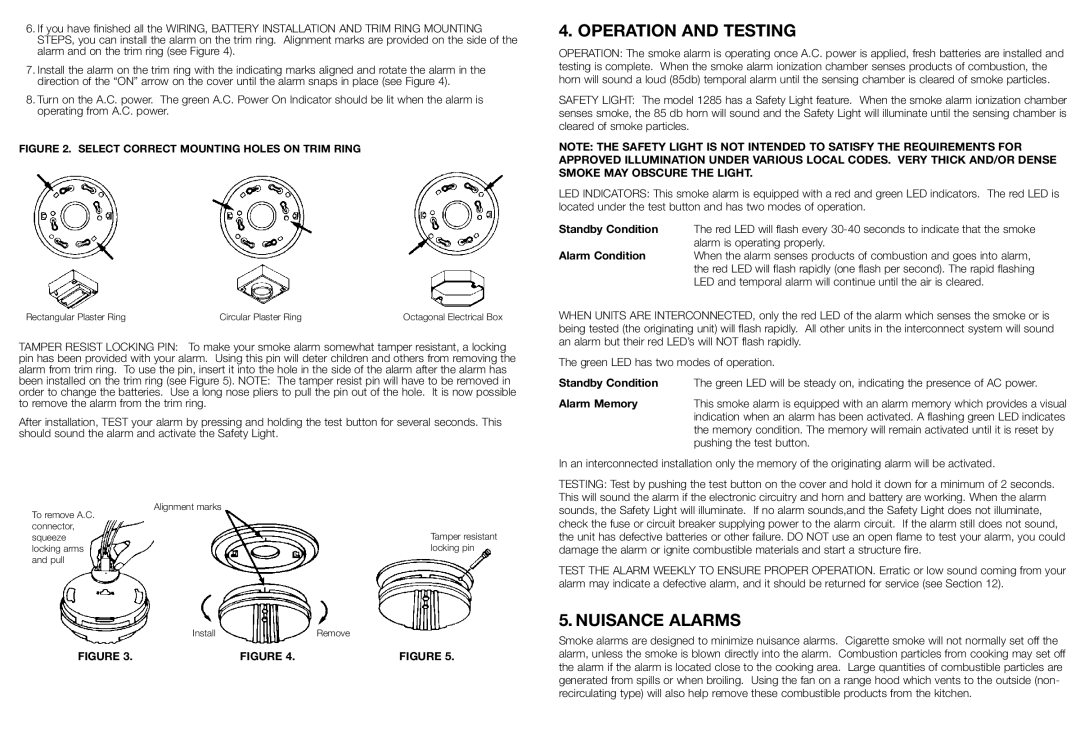
6.If you have finished all the WIRING, BATTERY INSTALLATION AND TRIM RING MOUNTING STEPS, you can install the alarm on the trim ring. Alignment marks are provided on the side of the alarm and on the trim ring (see Figure 4).
7.Install the alarm on the trim ring with the indicating marks aligned and rotate the alarm in the direction of the “ON” arrow on the cover until the alarm snaps in place (see Figure 4).
8.Turn on the A.C. power. The green A.C. Power On Indicator should be lit when the alarm is operating from A.C. power.
FIGURE 2. SELECT CORRECT MOUNTING HOLES ON TRIM RING
Rectangular Plaster Ring |
| Circular Plaster Ring |
| Octagonal Electrical Box |
|
|
|
|
|
TAMPER RESIST LOCKING PIN: To make your smoke alarm somewhat tamper resistant, a locking pin has been provided with your alarm. Using this pin will deter children and others from removing the alarm from trim ring. To use the pin, insert it into the hole in the side of the alarm after the alarm has been installed on the trim ring (see Figure 5). NOTE: The tamper resist pin will have to be removed in order to change the batteries. Use a long nose pliers to pull the pin out of the hole. It is now possible to remove the alarm from the trim ring.
After installation, TEST your alarm by pressing and holding the test button for several seconds. This should sound the alarm and activate the Safety Light.
To remove A.C. | Alignment marks |
|
|
| |
connector, |
| Tamper resistant |
squeeze |
| |
locking arms |
| locking pin |
and pull |
|
|
| Install | Remove |
FIGURE 3. | FIGURE 4. | FIGURE 5. |
4. OPERATION AND TESTING
OPERATION: The smoke alarm is operating once A.C. power is applied, fresh batteries are installed and testing is complete. When the smoke alarm ionization chamber senses products of combustion, the horn will sound a loud (85db) temporal alarm until the sensing chamber is cleared of smoke particles.
SAFETY LIGHT: The model 1285 has a Safety Light feature. When the smoke alarm ionization chamber senses smoke, the 85 db horn will sound and the Safety Light will illuminate until the sensing chamber is cleared of smoke particles.
NOTE: THE SAFETY LIGHT IS NOT INTENDED TO SATISFY THE REQUIREMENTS FOR APPROVED ILLUMINATION UNDER VARIOUS LOCAL CODES. VERY THICK AND/OR DENSE SMOKE MAY OBSCURE THE LIGHT.
LED INDICATORS: This smoke alarm is equipped with a red and green LED indicators. The red LED is located under the test button and has two modes of operation.
Standby Condition The red LED will flash every
Alarm Condition When the alarm senses products of combustion and goes into alarm, the red LED will flash rapidly (one flash per second). The rapid flashing LED and temporal alarm will continue until the air is cleared.
WHEN UNITS ARE INTERCONNECTED, only the red LED of the alarm which senses the smoke or is being tested (the originating unit) will flash rapidly. All other units in the interconnect system will sound an alarm but their red LED’s will NOT flash rapidly.
The green LED has two modes of operation.
Standby Condition | The green LED will be steady on, indicating the presence of AC power. |
Alarm Memory | This smoke alarm is equipped with an alarm memory which provides a visual |
| indication when an alarm has been activated. A flashing green LED indicates |
| the memory condition. The memory will remain activated until it is reset by |
| pushing the test button. |
In an interconnected installation only the memory of the originating alarm will be activated.
TESTING: Test by pushing the test button on the cover and hold it down for a minimum of 2 seconds. This will sound the alarm if the electronic circuitry and horn and battery are working. When the alarm sounds, the Safety Light will illuminate. If no alarm sounds,and the Safety Light does not illuminate, check the fuse or circuit breaker supplying power to the alarm circuit. If the alarm still does not sound, the unit has defective batteries or other failure. DO NOT use an open flame to test your alarm, you could damage the alarm or ignite combustible materials and start a structure fire.
TEST THE ALARM WEEKLY TO ENSURE PROPER OPERATION. Erratic or low sound coming from your alarm may indicate a defective alarm, and it should be returned for service (see Section 12).
5. NUISANCE ALARMS
Smoke alarms are designed to minimize nuisance alarms. Cigarette smoke will not normally set off the alarm, unless the smoke is blown directly into the alarm. Combustion particles from cooking may set off the alarm if the alarm is located close to the cooking area. Large quantities of combustible particles are generated from spills or when broiling. Using the fan on a range hood which vents to the outside (non- recirculating type) will also help remove these combustible products from the kitchen.
